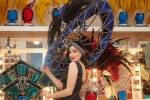Tennis figurines show once-proper attire
Tennis is an ancient game first played in Greece. It's mentioned in a play in the Middle Ages when a shepherd gives a tennis ball to the baby Jesus.
Early tennis games were played without rackets; the ball was hit with a bare hand, then later a glove. By the 16th century, a racket was used, and the tennis court was established. The game was a popular recreational sport in France by the 17th century, but it was not until the 1850s that the modern game of tennis was created.
A tennis club was formed in England in 1872, tennis games were first played in the United States in 1874 and the U.S. Open started in 1881. There was special dress for tennis even then.
Women wore properly modest outfits: a dress with a below-the-knee skirt, high neck and elbow-length sleeves, along with high socks and a prim cap. Men wore knickers, long-sleeved shirts with collars, high socks and the same type of cap.
Tennis-related figurines have been made by German, French and English companies. The appropriate dress, racket and balls were all part of the ceramic figure. Any sports-related figurine is popular today, and those from the 19th century bring high prices.
Q: I have a plastic chair my mother gave me. She said I used it as a little boy 40 years ago, but that the chair is at least 75 years old. The marks on the back say "Martest by Virco, Los Angeles, Calif., Conway, Ark." Can you tell me the chair's history and value?
A: Your chair is not 75 years old. Virco Manufacturing Corp., headquartered in Torrance, Calif., is a leading U.S. manufacturer of furniture for K-12 schools. But the company wasn't founded until 1950, and a spokesman for Virco told us your chair is probably from its 9000 Classic Series line of one-piece soft plastic chair shells, introduced in 1965.
"Martest" was the trade name for the chairs. They came in eight heights, ranging from 11 inches to 18 inches, and were made in blue, yellow, beige, green and orange. Virco introduced hard plastic chairs in the 1970s, and since then the Martest name has been used for a hard plastic line.
Q: I found a planter left in an abandoned building. The planter appears to be old, and I found a picture of it in a book about McCoy pottery. The odd thing about it is the impressed mark. It's the word "McCoy," but it's backwards. Have you seen this before? Is it rare?
A: Your planter was made by the Nelson McCoy Pottery Co. of Roseville, Ohio. The pottery was in business under that name from 1933 to 1990.
We have seen the backwards McCoy mark, but it's rare. Collectors call it the "mirror-image" mark. How it happened to be used on a few McCoy pieces is a mystery.
The mirror-image mark does not make your piece more valuable, but it proves your piece is not a fake -- and there are a lot of fake McCoy pieces on the market.
Q: I found an unusual piece of art in a dumpster and hope you can tell me more about it. It's a 30-by-30-by-8-inch framed picture of a wreath surrounding a corsage. What's so unusual is that the design is made of woven strands of different colors of hair assembled with wire and decorated with tiny beads. It's signed on the back by the sisters who did the hairwork in 1879 and there's also a note saying the piece was sold at the county fair in Baraboo, Wis., in 1924. Do you know what it's worth and who the heck would buy it?
A: You have a hairwork wreath mounted in a shadowbox. Hairwork jewelry and shadowboxes were popular during the Victorian era. Women worked on them at home, but some were made commercially. A lot of the jewelry was made as "mementoes mori" -- mementos to remind the wearer of a deceased loved one.
There are collectors of hairwork jewelry and wreaths who would be interested in buying your rescued piece. If it's in good condition, it could sell for up to $200.
Q: About 75 years ago, I got two enameled metal pins in the shape of Popeye characters. One is Popeye himself, 1 3/8 inches high, and the other is that odd animal, Eugene the Jeep, 11/2 inches high. Are the pins valuable?
A: If the pins are in great shape, they're valuable. Both were product premiums offered by sponsors of the Popeye radio series, which aired from 1935 to 1938.
The Popeye pin was one of three Wheatena cereal premiums (the other two were Olive Oyl and Wimpy). The Jeep pin was a Popsicle premium. Wheatena sponsored the show from 1935 to 1937, and Popsicle was a sponsor in 1938. Your Popeye pin, in near-mint condition, is valued at $80. Your Jeep pin is rarer and, if near-mint, could sell for more than $250. Collectors love old radio premiums.
Q: Is it true that some Chase lamps were made from parts of toilets? I have a short lamp with a round copper base and a lampshade shaped like a short cone.
A: Yes. The Chase Copper and Brass Co. lighting division made many types of lamps. The division, active in the 1930s and '40s, made hundreds of different lamps, ranging from classic shapes to childlike figures, ship's wheels, globes and very modern forms.
The Glow Lamp, designed by Ruth Gerth, used a copper toilet float as the round base. Other Chase pieces, including watering cans, pitchers and vases, also used the copper float. The company was able to cut costs by using existing parts like floats, copper tubing used for plumbing and even parts of other lamps.
Ralph and Terry Kovel's column is syndicated by King Features. Write to: Kovels, (Las Vegas Review-Journal), King Features Syndicate, 888 Seventh Ave., New York, NY 10019.























